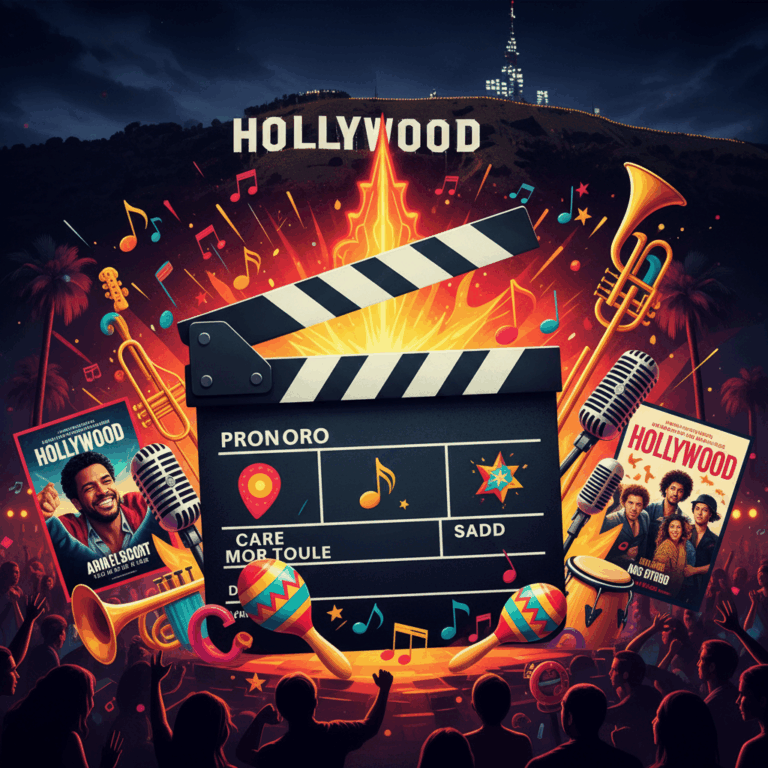History and origins of Latin songs in Hollywood
From the early years of sound film, Hollywood incorporated Latin music to add rhythm and color to its productions. These early uses reflected an idealized vision of Latin America.
Latin music was often interpreted through stereotypes that mixed Spanish and Caribbean rhythms, although they did not always represent the real Latin American diversity.
These early sounds helped create a recognizable, albeit limited, musical image that sought to evoke Latin culture in a way that was accessible to the American public.
Early incorporations of Latin music into sound films
In the era of sound cinema, films such as "The Kid from Spain" (1932) incorporated habaneras and pieces like "La Paloma" to set their stories in Latin America.
The use of guitars, melodic modes, and specific rhythms helped to create an exotic and sensual atmosphere that cinema sought to represent in its Latin settings.
Despite their popularity, these early additions were a stylized and often imprecise mix that grouped diverse Latin American musical cultures under clichés.
Stereotypes and musical genres represented
The most common musical genres in these early productions were the habanera, the pasodoble, and the rumba, often linked more to the Spanish or Caribbean idea than to the Latin world in general.
These styles were used to reinforce stereotypes of passion, exoticism, and romanticism, simplifying the cultural richness of Latin America for the Hollywood audience.
Over time, this approach began to be questioned, but even in its beginnings Latin music served as a bridge to introduce these rhythms to North American cinema.
Evolution and promotion of Latin hits in films
Latin music has evolved in Hollywood, gaining prominence in soundtracks that promote artists and bring diverse rhythms closer to a global audience.
Great hits have transcended borders, becoming cultural symbols that reinforce the Latino presence in the American film industry.
This growth reflects not only commercial absorption but also the authentic recognition of the artistic value of Latin music in film.
Impact of “La Bamba” in the 80s
The film “La Bamba” (1987) was a milestone that brought Latin rock to worldwide fame, with the iconic song performed by Ritchie Valens.
This film solidified Chicano music in the American imagination, giving space to the cultural and musical diversity of the Latino community.
The song's popularity helped spread Latin rhythms beyond specific niches, opening doors for future projects in Hollywood.
Latin music in blockbuster films of the 90s and 2000s
In the following decades, artists such as Jennifer Lopez and Shakira contributed songs that were integrated into major productions, increasing their global exposure.
Movies like Shall We Dance? and Zootopia showcased Latin hits like "Try Everything," which resonate especially with Spanish-speaking audiences.
This phenomenon strengthened the link between Latin music and film, revitalizing both sectors and expanding their markets.
Iconic songs in recent animated films
Recent animated films like Coco stand out for incorporating authentic Mexican music, with songs that resonated worldwide.
“Remember Me” became a cultural symbol, winning the Oscar for Best Original Song and transcending language barriers.
These successes reveal how Latin music can enrich visual and emotional narratives, strengthening cultural identity in Hollywood.
Current influence of Latin music in Hollywood
Today, Latin music plays a prominent role in Hollywood, where recent hits enrich trailers and key scenes, bringing energy and cultural diversity.
This influence reflects the global growth of Latin music, which is now key to connecting with multicultural audiences and bringing authenticity to productions.
Furthermore, collaboration between Latin artists and the film industry has increased, offering original soundtracks with rhythms typical of the region.
Use of Latin hits in trailers and featured scenes
Hits like “Despacito” have been incorporated into trailers and iconic movie moments, demonstrating the popularity and drawing power of Latin music.
The inclusion of these songs allows Hollywood to showcase a multicultural and modern character, reflecting the diversity of the audience and adding dynamism to the scenes.
Its use not only attracts the Spanish-speaking audience but also increases the global visibility of Latin genres on international platforms.
Contemporary productions with original Latin music
Recent films like Encanto stand out for incorporating original music created by Latin artists, fusing traditional sounds with modern elements.
Artists such as Carlos Vives and Sebastián Yatra collaborate on these productions, creating soundtracks that reflect the cultural and musical richness of Latin America.
This approach strengthens the link between Latin music and film, promoting regional identity and generating a significant impact on the global public.
Functions and effects of Latin music in film
Latin music in film not only provides rhythm, but also functions as a means to represent and construct the Latin American identity on the screen.
Through melodies, lyrics, and styles, cinema uses these themes to convey emotions and cultural values, reinforcing an authentic connection with the Latino audience.
Furthermore, the inclusion of Latin music favors the global visibility of these artistic expressions and creates an essential cultural bridge between the music and film industries.
Representation and construction of Latin American identity
Latin music in Hollywood films contributes to the creation of a cultural image that blends tradition and modernity, reflecting the diversity of Latin America.
Through characteristic sounds, Latin stories and characters are represented, helping to make their identity visible in a global context.
This representation strengthens the sense of belonging among Latin audiences and allows the international public to appreciate the cultural richness of the continent.
Global visibility and cultural connection between the music and film industries
The use of Latin songs in film amplifies the presence of these rhythms in international markets, boosting careers and opening up new audiences for artists.
Film and music projects benefit each other, creating synergies that promote cultural diversity and artistic recognition worldwide.
Thus, cinema positions itself as a vital platform for the dissemination and global appreciation of Latin music in its multiple genres and styles.






